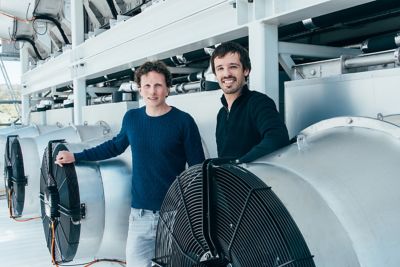ANSYS BLOG
April 22, 2021
Earth Day 2021: Simulation Advances Sustainability
Engineers understand that the individual components they design and simulate are part of larger assemblies, which are part of larger systems, which are part of an ecosystem. Everything is connected, with one component relying on another to ensure the final product meets requirements and works as intended. The parallels with our own environment and sustainability goals are clear. We all have to do our part to better our environment, and engineers are in a position to have a profound impact.
This Earth Day, let’s consider how simulation is allowing our customers to create products that reduce our carbon footprint, improve our energy efficiency, advance alternative energy sources and understand the environmental impact of the materials we use. Here are a few examples of how engineers are doing their part to make our world a better place.
Climeworks founders Christoph Gebald (l) and Jan Wurzbacher in front of the Climeworks plant Copyright Climeworks. Photo by Julia Dunlop
Simulation Changes the Climate Change Equation
Excess carbon dioxide (CO2) in the atmosphere traps heat and contributes to a warmer planet, altering weather patterns. So why not just remove the excess CO2? It’s not that easy. At only 400 parts per million, CO2 is exceptionally diffuse, making capture tedious and tough — and until now, quite expensive.
Swiss company Climeworks is tackling those challenges with its carbon dioxide removal solution. The company has developed a commercially viable, filter-based direct air capture (DAC) technology. By accessing Ansys simulation software as a partner in the Ansys Startup Program, Climeworks increased the filter capability of its DAC plants, streamlined the facilities’ energy consumption, and reduced fatigue and failure risk under mechanical loading cycles.
Learn all about the company’s efforts to remove CO2 from the air and store it permanently underground and their use of simulation.
Lightyear engineers are using Ansys simulation solutions to design the structure, aerodynamics, and electromagnetic and thermal properties of Lightyear One solar car. Image courtesy of Lightyear
Another member of the Ansys Startup Program, Lightyear, is revolutionizing the concept of the eco-friendly automobile by constructing the roof out of solar cells. The automotive company based in Helmond, the Netherlands, is designing the Lightyear One car from scratch — including the lightweight aluminum and carbon fiber chassis, the four in-wheel motors, the powertrain and the solar roof — using Ansys Mechanical, Ansys Fluent and Ansys HFSS to analyze structural, aerodynamic, electromagnetic and thermal properties of the five-seater.
Get the whole story here to see how Lightyear has evolved from Solar Team Eindhoven, the student engineering team that won the Bridgestone World Solar Challenge four times in a row, to a startup taking orders for delivery at the end of this year.
Speaking of competitions, check out how Air Race E, the first all-electric airplane race series, serves as a testbed for new technologies that will shape the future of more sustainable aviation. Recognizing that simulation is the only practical way to get these aircraft to the start line in time for the first race, Air Race E has partnered with Ansys to enable the competing teams to access the portfolio of simulation tools they need — from systems and embedded software to electromagnetics, fluids and mechanical.
Whole vehicle drag sensitivity and regions selected for optimization (1. side mirror, 2. A pillar, 3. air dam, 4. rear lamp). Image courtesy SAIC Volkswagen
Of course, established companies are also using simulation to create more sustainable products. Engineers at SAIC Volkswagen in Shanghai are using Ansys Fluent Adjoint Solver to reduce drag in automobiles, which will improve energy efficiency. Engineers used Fluent to gain insight into areas of particular drag sensitivity, then focused on finding ways to reduce drag in those specific areas.
Learn how SAIC Volkswagen engineers used the Fluent Adjoint Solver to solve an aerodynamic optimization challenge in a matter of hours rather than days, allowing them to perform a far greater number of simulations in the time allotted.
Realize the Sustainable Promise of Energy Efficiency
New applications are expanding the use of alternative energy sources, promising to lower carbon emissions. For example, hydrogen could be directly used in fuel cells for carbon-free power, or in gas turbines where its high energy density, higher auto-ignition temperatures and ability to lean-burn are favored. Simulation is helping to make these applications possible.
Burning hydrogen in engines poses several challenges, including flashback, acoustic instabilities, autoignition and flame holding inside the burner. Learn how engineers are addressing these challenges by applying high fidelity and validated scale resolving turbulence models, combustion models and fast transient numerics.
Contours of a combustion air pressure profile across a forced draft fan, air preheater, air plenum and burner. Image courtesy of Tailwater Technical Consulting LLC
New applications are exciting, but there is much that can be done to improve the efficiency of our established energy sources. For example, simulation enables the oil and gas industry to improve efficiency and reduce emissions of fired heaters. In a fired heater, thermal energy is released by combustion of fuel (gas, oil or both) and is then transferred to process fluids via radiant and convection tubes. However, all the energy supplied by combustion is not transferred to the tubes; thus fired heaters are major consumers of energy within the oil and gas industry. Improving the efficiency of the heaters decreases energy consumption, thus reducing operating costs.
Learn how Ansys Fluent allows engineers to visualize design details of fired heaters, enabling them to improve efficiency and reduce emissions.
Not all energy improvements are as technically complicated. In rural Cameroon, Africa, Engineers Without Borders volunteers are using Ansys Fluent and SpaceClaim to develop a simplified water-powered turbine that is easy to build, install and maintain. This abundance of flowing water during the rainy season inspired them to develop a Kaplan hydroelectric turbine to place in flowing streams. The water turns an impeller that generates electricity.
See how the engineers used Fluent and SpaceClaim to modify the turbine to make it more efficient, increasing its power output while dealing with silt buildup and other challenges.
Ensuring Material Matters to the Next Generation of Engineers
Climate challenges, conservation, restoration and pollution are not problems that will be fixed overnight. They require continuous attention to ensure the latest and greatest technologies are being applied to address them. As such, educating the next generation of engineers is vital.
One rapidly evolving sector is material information management. Materials are so critical to every step of developing sustainable products — from determining whether products can be manufactured efficiently to reduce waste, to using lighter materials that help reduce fuel consumption, to ensuring they can be recycled. Companies across the board need material data to help them meet stringent environmental standards and their own waste reduction and cost saving goals.
Ansys Granta products have been developed over 25 years to enable you to capture, safeguard and capitalize on your organization’s Material Intelligence.
Ansys Granta offers a range of materials information management software, designed for companies to realize their in-house Material Intelligence. One solution, Ansys Granta EduPack, is a set of teaching resources that help academics enhance courses related to materials across engineering, design, science and sustainable development.
Learn how Ansys is helping educators teach the next generation of engineers how important material information management is to the future of our planet.
Technology is allowing us to extend interconnectivity beyond the product and into the environment where the product is used, maintained and eventually reaches the end of its life cycle. At Ansys, we are proud to share how our customers are using simulation to improve the environment via our blog, Ansys Advantage magazine and events like Simulation World. Subscribe for more simulation stories.
For more information on Earth Day and the activities happening all year long, visit EarthDay.org.




